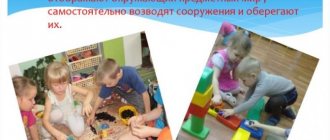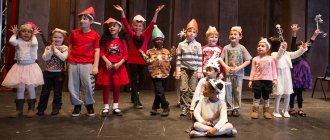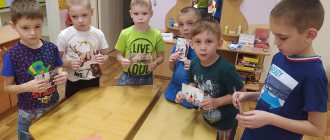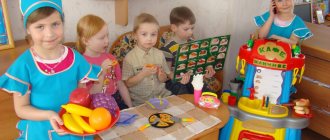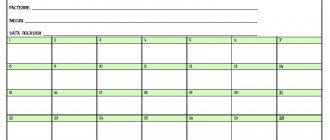Plot
First of all, we are talking about the plot content of the game. During the shift, the child experiences the development of the story that the authors put into their work. For a general epic game, the plot is the same for all ages, but the secondary scenarios may differ in groups of different ages. For example, stories about love, betrayal, and enmity can be found more often in senior units, because participants more easily distinguish the game from real life. They understand that just because one player attacked you during a game, this does not mean that he wants harm to you in real life. For preschoolers, for example, such stories are unacceptable.
The meaning of role-playing games
Regardless of what types of role-playing games your child prefers, they will help him prepare for the transition to a higher stage of development. This kind of fun not only captivates and entertains, it:
- They teach you to follow the rules. It is difficult for children to do what they don’t want to do. The desire to follow the rules will not appear on its own. Role-playing games will teach you this, because their essence lies in observing norms of behavior. By mastering the lives of adults, children begin to understand their moral principles, motivation and goals of activity. In addition, children develop a positive attitude towards people’s lives, their actions, and the rules of behavior in society.
- They form emotions. The child distinguishes fantasy from reality, this is confirmed by his words “pretend”, “really”, “as if”, but this does not prevent him from experiencing real emotions. Play activities reveal and shape children's feelings. Imagining herself as the mother of a “little child”, who is represented by a doll, the girl does not just repeat certain manipulations after her parents, but truly loves him. When a child acts as a hero who has completed an important task, he feels a sense of pride and responsibility for the task assigned. These experiences leave a deep imprint on the mind and shape the child’s emotional world.
- Develop intelligence. In the process of play activities, children of preschool age awaken interest in life events, professional activities of adults, and favorite heroes appear, whom they strive to imitate. Often the fun is not limited to one day, it is repeated several times. At the same time, the plot acquires new details and details. Thanks to this, children's thinking becomes purposeful and moves to a higher level of development.
- Train your imagination. Any children's game involves improvisation. The pre-conceived plot is filled with unpredictable twists: a captured enemy spy turns out to be “one of our own,” polar bears in the Arctic are eager to eat, and a princess getting ready for a ball urgently needs to put on makeup. The development of imagination affects the inclusion in the process of combinations from various life situations, elements from fairy tales or theatrical productions.
- Expand vocabulary. There is a two-way connection between speech and play. On the one hand, entertainment develops and activates speech, on the other, an increase in vocabulary makes the plot more interesting. The child uses words to designate his actions, which allows him to comprehend them, supplement them, and express thoughts and feelings. The development of vocabulary is especially significant in “director’s” productions, where you have to speak for all the characters in turn.
Children begin to be interested in role-playing games at about three years of age. At this age, children can already use objects not only for their intended purpose, but also according to an invented scenario. The sooner they begin to try on different images, the faster they will develop and enrich their activities. You can see how the complexity of entertainment changes as children grow older. Read more information about toys and their role in children's lives in our new article.
Organization
The organization of a role-playing game also suggests that the method of interaction between players may differ depending on age. So, in senior units, you can simulate activities during battles, medical operations, etc. A characteristic feature of younger guys is that their gameplay is largely quest-based, i.e. implies a linear progression of events prepared in advance by the masters. Middle age can carry out any gaming activity if it sees direct motivation for action. All these are conventions, but masters always take into account the age characteristics of the participants in their games.
An important element in preparing for role-playing activities is the stage of creating a role. Older players can quickly adapt to game conditions and immerse themselves in the life of their character, even if it consists of several sheets of personal introduction. The main way to get younger kids interested is to demonstrate some of the gameplay in action so that participants can get a feel for what they might enjoy about role-playing. Thus, in Ariadne’s Threads, before the start of plot-role interaction, shift participants play so-called small role-playing games. They are aimed at ensuring that each child can practice acting out his role, as well as understand what role-playing game itself is like.
Technologies of plot-role-playing games in different age groups. - presentation
The technology of role-playing games in different age groups
is related to social reality. The themes of role-playing games are mainly related to social reality. At the same time, both real and fantastic events can be intertwined in one plot-role-playing game. The development of plotting methods occurs through inventing and combining various situations of interaction between people and events.
Pedagogical support for role-playing games involves: - organizing joint activities and co-creation of the teacher and children in preparation for the game: accumulating content for games, modeling possible game situations; — creative creation of an environment for the game; — organizing joint games between the teacher and children, in which new skills and new content are learned; -creating conditions for independent initiative and creative play activities of children.
Stages of pedagogical technology: Stage 1: Enriching ideas about the sphere of reality that the child will display in the game - observations, stories, conversations about impressions. It is important to introduce the child to people, their activities, relationships (who does what and why).
Stage 2: Organization of a role-playing game (“game of preparation for the game”): - identifying situations of interaction between people, thinking through and combining events, the course of their development in accordance with the theme of the game; — creation of an object-based play environment based on the organization of children’s productive and artistic activities, co-creation with the teacher, and children’s collecting; - joint play activities between the teacher and children.
Stage 3: Independent play activities of children. Organizing a role-playing game with an imaginary partner for whom the child speaks. This game teaches subordination of motives, coordination of roles, and mutual understanding.
Algorithm for interaction between a teacher and children in a role-playing game
Organization of joint activities and co-creation of the teacher and children The organization of role-playing games on topics reflecting social reality is based on the direct experience of children, which, due to modern conditions, the child receives mainly outside the walls of the preschool educational institution. The success of reflecting impressions in the game depends on what the child saw. A special place at this stage is occupied by children’s conversations and stories about impressions received in direct experience. During the conversation, it is important to help children identify situations for play display and help activate their play imagination.
During the discussion, it is important to identify for children the incompleteness and uncertainty of some of their ideas and to evoke a desire to clarify, detail, and expand their knowledge. One of the ways to fill in the missing information is to ask parents, educators, and representatives of various professions (for this purpose, the teacher organizes interaction with the families of the students). Questioning contributes to the development of cognitive activity in preschoolers, as children begin to formulate questions and social contacts expand.
During the conversation between the teacher and the children, a bank of ideas is gradually created. The most interesting situations chosen for games are recorded using symbols, conventional images, and short captions for them. Gradually, thematic card indexes appear in the kindergarten group, related to different aspects of social reality, which reflect the immediate impressions and interests of children. Organizing a role-playing game requires the use of appropriate attributes. Collecting will help here - putting together collections of items necessary for the game.
The stage of preparation for the game includes joint productive activities of the teacher and children in the manufacture of attributes for the game. Co-creation between the teacher and children creates the conditions for the transition from play to preparation for play, to independent role-playing play, in which plans are realized and new ideas are formed. The pre-game phase is essentially a game of preparation for the game and can be longer than the game itself. The value of this stage lies in organizing meaningful and interesting communication between children and adults both in kindergarten and beyond. The preparatory stage for the game is the game project activity of preschoolers. The preparatory stage for the game can be the game project activity of preschoolers. Project activities, solving the problems of the educational program, make cognitive content attractive for display in the game.
Levels of role-playing play: from 3 to 7 years
The main indicator of the development of the game is its sequence: the beginning of the process, the culmination and the logical conclusion. Observing children during activities helps adults notice behavioral deviations at an early age and make efforts to eliminate them. Child psychologists find a relationship between the child’s age, his level of development and the complexity of play activities:
- 3-4 years. Mostly kids play with adults, whose help at this stage is quite significant. Parents come up with a plot, hold an imaginary situation, guide the children and provide guidance. Children often try to play on their own, but such activities are usually short-term and limited to a couple of actions: wash the dishes, put the doll to bed, feed the teddy bear. The plot does not unfold further - no one eats, no one praises them for clean plates, and no one wakes up. At this stage, the game should teach children to act according to the script, develop imagination and enrich their vocabulary.
- 4-5 years. From this age, children begin to master simple plot directions in which they try on various images: a mother, a sister, or a doctor from a children's clinic. They actively interact with toys, talking for themselves and for them. At this age, children can already join groups (2-3 people) for joint activities. The company helps 4-5 year old players develop communication skills, teaches how to conduct a dialogue, independently distribute responsibilities and select toys.
- 5-6 years. The main focus of the game is the relationships between people, whose roles the children distribute among themselves. Toys are selected to match the invented scenario. The everyday theme is complemented by work activities and significant events in life. Must be consistent with the character and actions of the assigned role. While playing, the child develops the ability to determine the rules and change the plot, activates dialogical speech, enriches his social experience (learns the rules of behavior on the road, in transport, cafes, shops, etc.)
- 6-7 years. At this stage, children act meaningfully, aware of their relationships with partners. While playing out scenes, they jealously monitor their friends’ compliance with generally accepted rules: “Dads don’t act like that,” “Dinner doesn’t start with the second course,” “Girls don’t behave like that”—such phrases are often heard in the company of older preschool-age children. Creative role-playing games with exciting plots, content, new characters, and a fairy-tale world come to the fore. The children themselves prepare the scenery and attributes, select toys, and add elements of dance and singing to the scenes.
Play is the leading activity of a preschooler and occupies an important place in his life. Children are transported from everyday routine to an imaginary situation, try on interesting roles, use images and imagination to act in the play space. At this time, adults receive in their hands a powerful tool for influencing the child’s future inclinations, his actions and character. You can read about the benefits of wooden toys in the article “Wooden educational toys: features and benefits for children.”
